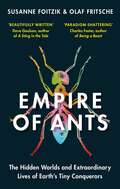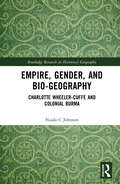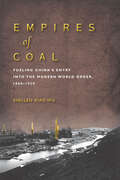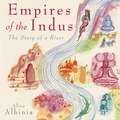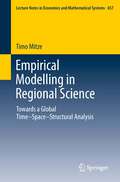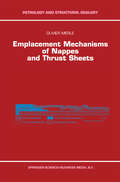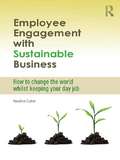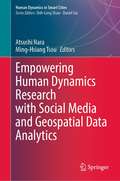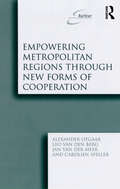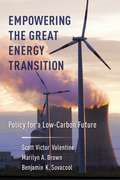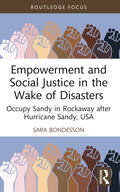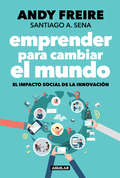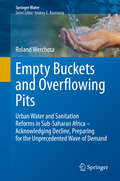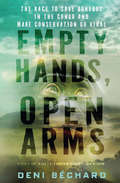- Table View
- List View
Empire and Environmental Anxiety
by James BeattieA new interpretation of imperialism and environmental change, and the anxieties imperialism generated through environmental transformation and interaction with unknown landscapes. Tying together South Asia and Australasia, this book demonstrates how environmental anxieties led to increasing state resource management, conservation, and urban reform.
Empire of Ants: The hidden worlds and extraordinary lives of Earth's tiny conquerors
by Olaf Fritsche Susanne Foitzik'Beautifully written and filled with mind-boggling wonders' - Dave Goulson, author of A Sting in the Tale'Thrilling, compellingly readable and paradigm-shattering' - Charles Foster, author of Being a Beast'Both expert and entertaining' - David Barrie, author of Incredible JourneysAnts have been walking the Earth since the age of the dinosaurs. Today there are one million ants for every one of us. The closer you get to ants, the more human they look: they build megacities, grow crops, raise livestock, tend their young and infirm, and even make vaccines. They also have a darker side: they wage war, enslave rivals and rebel against their oppressors. From fearsome army ants, who stage twelve-hour hunting raids where they devour thousands, to gentle leaf-cutters gardening in their peaceful underground kingdoms, every ant is engineered by nature to fulfil their particular role.Acclaimed biologist Susanne Foitzik has travelled the globe to study these master architects of Earth. Joined by journalist Olaf Fritsche, Foitzik invites readers deep into her world - in the field and in the lab - and will inspire new respect for ants as a global superpower.Fascinating and action-packed, Empire of Ants will open your eyes to the secret societies thriving right beneath your feet.
Empire of Ants: The hidden worlds and extraordinary lives of Earth's tiny conquerors
by Olaf Fritsche Susanne FoitzikAnts have been walking the Earth since the age of the dinosaurs. Today there are one million ants for every one of us. The closer you get to ants, the more human they look: they build megacities, grow crops, raise livestock, tend their young and infirm, and even make vaccines. They also have a darker side: they wage war, enslave rivals and rebel against their oppressors. From fearsome army ants, who stage twelve-hour hunting raids where they devour thousands, to gentle leafcutters gardening in their peaceful underground kingdoms, every ant is engineered by nature to fulfil their particular role.Acclaimed biologist Susanne Foitzik has travelled the globe to study these master architects of Earth. Joined by journalist Olaf Fritsche, Foitzik invites readers deep into her world - in the field and in the lab - and will inspire new respect for ants as a global superpower.Fascinating and action-packed, Empire of Ants will open your eyes to the secret societies thriving right beneath your feet.(p) Octopus Publishing Group 2021
Empire of Shadows: The Epic Story of Yellowstone
by George BlackThe story of the conquest of America's majestic national landmark, a landscape uninhabited, inaccessible, and shrouded in myth in the Civil War's aftermath.Los Angeles Times Book Prize Finalist“George Black rediscovers the history and lore of one of the planet's most magnificent landscapes. Read Empire of Shadows, and you'll never think of our first—in many ways our greatest—national park in the same way again.” —Hampton Sides, New York Times–bestselling authorEmpire of Shadows is the epic story of the conquest of Yellowstone, a landscape uninhabited, inaccessible and shrouded in myth in the aftermath of the Civil War. In a radical reinterpretation of the nineteenth century West, George Black casts Yellowstone's creation as the culmination of three interwoven strands of history—the passion for exploration, the violence of the Indian Wars and the “civilizing” of the frontier—and charts its course through the lives of those who sought to lay bare its mysteries: Lt. Gustavus Cheyney Doane, a gifted but tormented cavalryman known as “the man who invented Wonderland”; the ambitious former vigilante leader Nathaniel Langford; scientist Ferdinand Hayden, who brought photographer William Henry Jackson and painter Thomas Moran to Yellowstone; and Gen. Phil Sheridan, Civil War hero and architect of the Indian Wars, who finally succeeded in having the new National Park placed under the protection of the US Cavalry.George Black's Empire of Shadows is a groundbreaking historical account of the origins of Yellowstone—”epic, essential and often bloody” (Washington Post).“Masterful and riveting. . . . Will forever change our understanding and conception of this sacred American place.” —David Grann, #1 New York Times–bestselling author
Empire of Wild: A Novel
by Cherie DimalineA #1 INTERNATIONAL BESTSELLEROne of the most anticipated books of the summer for Time, Harper's Bazaar, Bustle and Publishers Weekly'Deftly written, gripping and informative. Empire of Wild is a rip-roaring read!' Margaret Atwood'Empire of Wild is doing everything I love in a contemporary novel and more. It is tough, funny, beautiful, honest and propulsive' Tommy Orange, author of There There 'Dimaline turns an old story into something newly haunting and resonant' New York Times'Close, tight, stark, beautiful - rich where richness is warranted, but spare where want and sorrow have sharpened every word. Dimaline has crafted something both current and timeless' NPR'Revelatory... Gritty and engaging, this story of a woman and her missing husband is one of candor, wit and tradition'Ms. Magazine Broken-hearted Joan has been searching for her husband, Victor, for almost a year - ever since he went missing on the night they had their first serious argument. One hung-over morning in a Walmart parking lot in a little town near Georgian Bay, she is drawn to a revival tent where the local Métis have been flocking to hear a charismatic preacher. By the time she staggers into the tent the service is over, but as she is about to leave, she hears an unmistakable voice.She turns, and there is Victor. Only he insists he is not Victor, but the Reverend Eugene Wolff, on a mission to bring his people to Jesus.With only two allies - her Johnny-Cash-loving, 12-year-old nephew Zeus, and Ajean, a foul-mouthed euchre shark with deep knowledge of the old Métis ways - Joan sets out to remind the Reverend Wolff of who he really is. If he really is Victor, his life and the life of everyone she loves, depends upon her success.Inspired by traditional Métis legends, Cherie Dimaline has created a propulsive, stunning and sensuous novel.
Empire, Gender, and Bio-geography: Charlotte Wheeler-Cuffe and Colonial Burma (Routledge Research in Historical Geography)
by Nuala C JohnsonThis book explores the relationships between empire, natural history, and gender in the production of geographical knowledge and its translation between colonial Burma and Britain. Focusing on the work of the plant collector, botanical illustrator, and naturalist, Charlotte Wheeler-Cuffe, this book illustrates how natural history was practised and produced by a woman working in the tropics from 1897 to 1921. Drawing on the extensive and under-studied archive of private and official correspondence, diaries, sketchbooks, photographs, paintings, and plant lists of Wheeler-Cuffe, this book advances our conceptual understanding of the 'invisible’ historical geographies underpinning scientific knowledge production, by focusing on the role of a female actor in the complex gendered setting of colonial Burma. Using a bio-geographical approach, this analysis reconceptualises female agency beyond authorship and publication, and stresses how Wheeler-Cuffe represents an instantiation of the occluded contribution of women to the historiography of natural history. This book highlights Wheeler-Cuffe’s production of scientific knowledge about Burma in the context of her relationship, as a white Western woman, with local, indigenous actors and details her practice of fieldwork and its embodied geographies in different parts of Burma, while she maintained the domestic superstructure of a colonial wife. This book will be of interest to advance-level students and researchers in historical and cultural geography; the history of science; feminist geography; women and natural history; colonial Burma and imperialism; and botanical art and illustration.
Empires of Coal: Fueling China's Entry into the Modern World Order, 1860-1920
by Shellen Xiao WuFrom 1868–1872, German geologist Ferdinand von Richthofen went on an expedition to China. His reports on what he found there would transform Western interest in China from the land of porcelain and tea to a repository of immense coal reserves. By the 1890s, European and American powers and the Qing state and local elites battled for control over the rights to these valuable mineral deposits. As coal went from a useful commodity to the essential fuel of industrialization, this vast natural resource would prove integral to the struggle for political control of China. Geology served both as the handmaiden to European imperialism and the rallying point of Chinese resistance to Western encroachment. In the late nineteenth century both foreign powers and the Chinese viewed control over mineral resources as the key to modernization and industrialization. When the first China Geological Survey began work in the 1910s, conceptions of natural resources had already shifted, and the Qing state expanded its control over mining rights, setting the precedent for the subsequent Republican and People's Republic of China regimes. In Empires of Coal, Shellen Xiao Wu argues that the changes specific to the late Qing were part of global trends in the nineteenth century, when the rise of science and industrialization destabilized global systems and caused widespread unrest and the toppling of ruling regimes around the world.
Empires of the Indus
by Alice Albinia10th anniversary edition with new PrefaceOne of the largest rivers in the world, the Indus rises in the Tibetan mountains, flows west across northern India and south through Pakistan. For millennia it has been worshipped as a god; for centuries used as a tool of imperial expansion; today it is the cement of Pakistans fractious union. Five thousand years ago, a string of sophisticated cities grew and traded on its banks. In the ruins of these elaborate metropolises, Sanskrit-speaking nomads explored the river, extolling its virtues in Indias most ancient text, the Rig-Veda. During the past two thousand years a series of invaders - Alexander the Great, Afghan Sultans, the British Raj - made conquering the Indus valley their quixotic mission. For the people of the river, meanwhile, the Indus valley became a nodal point on the Silk Road, a centre of Sufi pilgrimage and the birthplace of Sikhism. Empires of the Indus follows the river upstream and back in time, taking the reader on a voyage through two thousand miles of geography and more than five millennia of history redolent with contemporary importance.
Empirical Modelling in Regional Science
by Timo MitzeEconomic agents interact in structural relationships through time and space. This work starts from the empirical observation that all three dimensions, namely time, space, and structural functional forms, are important for an integrative framework of modern empirical analysis in regional science. The work thus aims at combining up-to-date econometric tools from the fields of spatial econometrics, panel time-series analysis and structural simultaneous equation modelling to analysis the different research questions at hand. Most of the topics dealt within this work start from a concrete empirical problem, while problem solving also aims at generating some new knowledge in a methodological way, e.g. by the complementary use of Monte Carlo simulation studies to compare the empirical performance of different estimators for specific data samples. Following a first introductory chapter, the work is structured in three parts addressing major issues in building up a stylized regional economic model such as interregional migration, factor and final demand estimation. All empirical applications use German regional data.
Empirical Regional Economics: Economic Base Theory, Models and Applications (Springer Texts in Business and Economics)
by Richard S. Conway Jr.This textbook offers an introduction to empirical regional economics, including a comprehensive and systematic overview of the fundamentals, history, development, and applications of economic base models. It not only provides a sound basis for regional economics and regional economic analysis, but it also includes numerous applications of the underlying theory. The book has an empirical orientation, highlighting the value of observation and testing in order to explain regional economic behavior. Theory plays an important role in this study, but it is only a starting point. The book is divided into three parts: the first discusses the economic base theory of regional growth and the empirical evidence supporting it, while the second part covers the specification and application of four increasingly complex regional economic models: the economic base model, the input-output model, the interindustry econometric model, and the structural time-series model. Lastly, the third part presents forty-eight regional economic case studies organized under seven headings, including economic cycles, economic policy, and regional forecasting. Given its scope, the book appeals to upper-undergraduate and graduate students majoring in economics, economic geography, and business, as well as to anyone in the private or public sector interested in gaining a better understanding of practical methods of regional economic forecasting and analysis.
Emplacement Mechanisms of Nappes and Thrust Sheets (Petrology and Structural Geology #9)
by Olivier MerleNappes and overthrusts are the mosl representative geological structures in mountain chains. The issue of their emplacement mechanisms and of the driving force of these displacements is a major problem in tectonics which interests, for near to a century now and not without harsh controversies, a significant proportion of structural geologists and geoscientists who work in the field of rock mechanics. This book attempts to give a clear and didactic synthesis of the current knowledge of the concept of thrusting, principally by tackling two approaches, mechanics and kinematics, which have proposed some solutions to this problem. At first (Chapter I), the notions of thrusting are defined, with the most recent terminology and the most important geometric aspects. This introduction to the geometry of thrusts is logically followed by the presentation of their problem; the issue of the emplacement mechanisms (Chapter 2). Let us note in passing that the formulation of the concept and the presentation of its problem are associated historically, which justifies presenting them in the historical framework of this discovery before tackling the different solutions and mechanical hypotheses. These are detailed in Chapter 3 by following a chronological progression, and emphasising the divergences and oppositions between different models so as to cover them fully. The chapter on the kinematics (Chapter 4) then returns to the type of data which can be collected in the field, by clarifying the relationships between displacement and internal strain.
Employee Engagement with Sustainable Business: How to Change the World Whilst Keeping Your Day Job (Routledge Explorations in Environmental Studies)
by Nadine ExterSustainability is, and continues to grow as, a key issue for organizations: in the board room; with investors, customers and regulators; and from employees whose demands on organizations include improving their social and environmental performance in return for loyalty and commitment. However, as well as employees being a driver for organizations to embrace corporate sustainability, employees are also one of the most critical assets in enabling an organisation to understand and be able to deliver to its economic, social and environmental responsibilities. Research shows that employees of all types are vital in the pursuit of sustainability, however, to date there is no one source that shows all of these identified types of employees and how they are involved in the sustainability process. This book fills that gap with interviews and case studies for each type of employee, as well as up-to-date research and analysis of the critical role of ‘social intrapreneurs’ and leaders within organisations. The book uses real life examples along with the latest research in an informative and accessible style. Management theory is used throughout – such as motivation, leadership skills and organisational behaviour – but this is discussed through examples, rather than in a theoretical manner. This book will provide insight, examples and advice on the different types of employees who are, and can, contribute to a sustainable world via the organisation they work for: what they are doing from within the organization to contribute to societal, economic and environmental sustainability.
Employment Location in Cities and Regions
by Alan Wilson David Simmonds Francesca Pagliara Michiel De BokThe focus of this book is the modeling of the location of economic activities, measured in terms of employment, in land-use and transportation systems. These measures are key inputs to models at intra-urban scales of the flows of persons and goods for both urban and transport planning. The models described here are either components of comprehensive models or specialist studies. Economic activities can be defined in terms of jobs or private-sector firms and public service organisations. Different levels of aggregation are used both in terms of organisational and geographical dimensions. In the case of firms and public organizations, a distinction can be made between the organizations themselves and corresponding establishments. For urban simulation models, it is the location of establishments that is important. At the more coarse levels of aggregation that are usually used in comprehensive models, firms and organizations are aggregated into sectors.
Empowering Climate Action in the United States (Resetting Our Future)
by Tom BowmanAn ACE National Strategic Planning Framework for the United States is a game changer for climate action. After decades of inspired but fragmented efforts, 150 highly diverse Action for Climate Empowerment (ACE) leaders joined forces in 2020 to build a strategic roadmap for encouraging, informing, and empowering the public to tackle the climate crisis. Their goal: push the United States and other nations to meet - and exceed - the targets of the Paris Agreement in the fastest and most equitable way possible, namely, by empowering the people.
Empowering Green Initiatives with IT
by Carl H. SpeshockA straightforward guide to the role of IT departments and vendor's in assisting organizations in going green with the aid of IT-related resources and offerings.This book provides organizations with strategy, planning, implementation, assessment guidance for their Green initiatives. It discusses the many benefits of Green initiatives with the assistance, integration and collaboration of IT department and vendors, i.e. custom and vendor application development and reporting tools, Green IT examples, business intelligence dashboards that can perform analytical and predictive analysis of green related business data.Outlines the major benefits to be gained through Green initiatives with ITShows you how your business can strategize, plan, implement, assess Green initiatives solutions with ITExplores how to develop Green initiative strategies, plans, projects, and assessments that integrate IT resources and offerings effectively.Practical and thorough, this book includes helpful checklists, glossary, and resources to get started with your business's Green initiatives.
Empowering Human Dynamics Research with Social Media and Geospatial Data Analytics (Human Dynamics in Smart Cities)
by Atsushi Nara Ming-Hsiang TsouThis book discusses theoretical backgrounds, techniques and methodologies, and applications of the current state-of-the-art human dynamics research utilizing social media and geospatial big data. It describes various forms of social media and big data with location information, theory development, data collection and management techniques, and analytical methodologies to conduct human dynamics research including geographic information systems (GIS), spatiotemporal data analytics, text mining and semantic analysis, machine learning, trajectory data analysis, and geovisualization. The book also covers applied interdisciplinary research examples ranging from disaster management, public health, urban geography, and spatiotemporal information diffusion. By providing theoretical foundations, solid empirical research backgrounds, techniques, and methodologies as well as application examples from diverse interdisciplinary fields, this book will be a valuable resource to students, researchers and practitioners who utilize or plan to employ social media and big data in their work.
Empowering Metropolitan Regions Through New Forms of Cooperation (Euricur Ser. (european Institute For Comparative Urban Research) Ser.)
by Leo van Berg Alexander Otgaar Carolien SpellerThis insightful book analyzes the development of cross-border and cross-sector partnerships in a number of European cities and regions. Including, amongst others, Copenhagen, Budapest, Helsinki, Munich and Catalonia, these case studies shed light on the factors determining the success or failure of the coalition-forming process. Over the course of the nine case studies, the following questions are addressed: - What forms of metropolitan and/or regional partnerships can be found? -
Empowering the Great Energy Transition: Policy for a Low-Carbon Future
by Scott Valentine Benjamin Sovacool Marilyn BrownAt a time when climate-change deniers hold the reins of power in the United States and international greenhouse gas negotiations continue at a slow crawl, what options are available to cities, companies, and consumers around the world who seek a cleaner future? Scott Victor Valentine, Marilyn A. Brown, and Benjamin K. Sovacool explore developments and strategies that will help fast-track the transition to renewable energy. They provide an expert analysis of the achievable steps that citizens, organizational leaders, and policy makers can take to put their commitments to sustainability into practice.Empowering the Great Energy Transition examines trends that suggest a transition away from carbon-intensive energy sources is inevitable—there are too many forces for change at work to stop a shift to clean energy. Yet under the status quo, change will be too slow to avert the worst consequences of climate change. Humanity is on a path to incur avoidable social, environmental, and economic costs. Valentine, Brown, and Sovacool argue that new policies and business models are needed to surmount the hurdles separating the current consumption model from a sustainable energy future. Empowering the Great Energy Transition shows that with well-placed efforts, we can set humanity on a course that supports entrepreneurs and communities in mitigating the environmental harm caused by technologies whose time has come and gone.
Empowerment and Social Justice in the Wake of Disasters: Occupy Sandy in Rockaway after Hurricane Sandy, USA (Routledge Studies in Hazards, Disaster Risk and Climate Change)
by Sara BondessonThis book taps into discussions about social vulnerability, empowerment, and resistance in relation to disaster relief and recovery. It disentangles tensions and dilemmas within post-disaster empowerment, through a rich ethnographic narrative of the work of Occupy Sandy in Rockaway, New York City, after Hurricane Sandy in 2012. It details both a remarkable collaborative relief phase, in which marginalized communities were empowered to take active part, as well as a phase of conflict and resistance that came about as relief turned to long-term recovery. This volume particularly aims to understand how community empowerment processes can breach pre-disaster marginalization in the aftermath of disasters. It connects with broader emancipatory literature on dilemmas involved in empowerment ‘from the outside’. In a future of potentially harsher climate related disasters and increased social vulnerability for certain communities, this book contributes to a full and nuanced understanding of community empowerment and vulnerability reduction. This book will be of interest to sociologists, anthropologists, geographers, political scientists, and urban studies researchers, as well as undergraduate and postgraduate students interested in disaster management, disaster risk reduction, social vulnerability, community empowerment, development studies, local studies, social work, community-based work, and emancipatory theory.
Emprender para cambiar el mundo: El impacto social de la innovación
by Andy Freire Santiago A. SenaAndy Freire con Santiago A. Sena nos presentan a los emprendedores sociales, quienes demuestran que el impacto social y la sostenibilidad económica no son lógicas contrapuestas, sino una alianza innovadora que cambia paradigmas en todo el mundo. Mientras el futuro aparece amenazante (la pérdida masiva de empleo por la automatización, el calentamiento global y las crisis humanitarias), estos emprendedores traen respuestas: generar un impacto social positivo y sustentable desde empresas que proveen bienes y servicios, tienen clientes, generan ganancias, son rentables y, al mismo tiempo, solucionan problemas sociales concretos. Su experiencia deja en claro que hay una nueva forma de encarar la vida laboral. El capitalismo puede ser salvaje, pero los emprendedores sociales se comprometen a domarlo y humanizarlo en beneficio de la sociedad.
Empty Buckets and Overflowing Pits: Urban Water and Sanitation Reforms in Sub-Saharan Africa – Acknowledging Decline, Preparing for the Unprecedented Wave of Demand (Springer Water)
by Roland WerchotaThis book provides a multi-level and multi-dimensional insight into urban water and sanitation development by analyzing sector reforms in Africa. With the recent events in mind - water shortages in Cape Town, widespread cholera in Haiti, mass-migration from low-income countries, etc. – it elaborates a pressing topic which is directly linked to the precarious living conditions of the urban poor in the developing countries. It is urgent to acknowledge the proposed findings and recommendations of the book which will help to improve the situation of potential refugees in their home countries with a realistic vision for the development of the most basic of all life supporting services.So many efforts to reverse the negative trend in water and sanitation development have failed or targets have been repeatedly missed by far without notable consequences for decision makers on different levels and institutions. It has unnecessarily consumed many young lives, contributed to keep billions in poverty until today and fostered discrimination of women. The knowledge gap and the confusion in the sector lined out in the book becomes evident when a national leader in a low-income country declares a state of emergency in urban water and sanitation while at the same time global monitoring publishes an access figure for urban water of over 90% for the same country. It is time to change this with an effective sector development concept for our partner countries and a more realistic discourse on global level.The book argues for a sweeping rethinking and combines extended local knowledge, lessons learned from history in advanced countries and thorough research on reforms in Francophone and Anglophone developing countries. This was possible because the writer was working in Sub-Saharan partner countries for almost 30 years as an integrated long term advisor in different sector institutions (ministry, regulator, financing basket and different sizes of utilities) and had the opportunity to cooperate closely with the main development partners.The reader has the opportunity to obtain a comprehensive understanding of how the sector works and sector institutions in low-income countries function and can discover the reasons behind success and failures of reforms. The book also covers issues which have a significant influence on urban water and sanitation development but are hardly the subject of discussions. It helps to make the shortcomings of the water and sanitation discourse more apparent and assist institutions to move beyond their present perceptions and agendas. All of this makes the book different from other literature about urban water and sanitation in the developing world.
Empty Hands, Open Arms: The Race to Save Bonobos in the Congo and Make Conservation Go Viral
by Deni Ellis Béchard&“Absorbing . . . Béchard&’s masterful, adventure-driven reporting delivers an inspiring account of an all-too-rare ecological success story.&” —Booklist Bonobos have captured the public imagination, due not least to their famously active sex lives. Less well known is the fact that these great apes don&’t kill their own kind, and that they share nearly 99% of our DNA. Their approach to building peaceful coalitions and sharing resources has much to teach us, particularly at a time when our violent ways have pushed them to the brink of extinction. Animated by a desire to understand bonobos and learn how to save them, Deni Ellis Béchard traveled into the Congo. Empty Hands, Open Arms is the account of this journey. Along the way, we see how partnerships between Congolese and Westerners, with few resources but a common purpose and respect for indigenous knowledge, have resulted in the protection of vast swaths of the rainforest. And we discover how small solutions—found through openness, humility, and the principle that poverty does not equal ignorance—are often most effective in tackling our biggest challenges. Combining elements of travelogue, journalism, and natural history, this incomparably rich book takes the reader not only deep into the Congo, but also into our past and future, revealing new ways to save the environment and ourselves. &“Riveting [and] surprisingly uplifting.&” —David Suzuki, author of The Sacred Balance &“The embodiment of the type of reporting that we dream of reading, but all too rarely encounter—intelligent, engaged, and above all, astonishingly perceptive.&” —Dinaw Mengestu, author of The Beautiful Things That Heaven Bears Also published as Of Bonobos and Men.
Empty Pastures: Confined Animals and the Transformation of the Rural Landscape
by Terence J. CentnerOver the past century American agriculture has shifted dramatically with small, commercial farms finding it increasingly difficult to compete with large-scale (mostly indoor) animal feeding operations (AFOs). In this book, Terence J. Centner investigates the environmental, social, economic, and political impact of the rise of the so-called factory farm, exposing the ramifications of the contemporary trend toward industrial-scale food production. Just as Rachel Carson's landmark Silent Spring used the disappearance of songbirds as a jumping-off point for a work that raised public awareness of pesticides' devastating environmental impact, Empty Pastures sees the dwindling numbers of livestock in the American countryside as a symptom of a broader transformation, one with serious consequences for the rural landscape and its inhabitants--animal as well as human. After outlining the rise of the AFO, Centner examines the troubling consequences of consolidation in animal farming and suggests a number of remedies. The issues he tackles include groundwater contamination, the loss of biodiversity, animal welfare, concentrated odors and other nuisances, soil erosion, and the economic effects of the disappearance of the small family farm. Inspired by largely abandoned traditional practices rather than a radical and unrealistic vision of a return to an idealized past, Centner proposes a series of pragmatic reforms for regulating factory farms to halt ecological degradation and revitalize rural communities.
Emu
by Pauline ReillyTells the story of the Emu, flightless bird of Australia, as he raises his family, and travels, and finds a new mate for the next year.
Emulating Natural Forest Landscape Disturbances: Concepts and Applications
by Ajith H. Perera Lisa J. Buse Michael G. WeberThis comprehensive collection of provocative papers provides a scientific foundation for justifying the use of and a solid framework for examining the ambiguities inherent in emulating natural forest landscape disturbance. Contributors range from policymakers and forestry professionals to academics and conservationists, offering a balanced view of the promises and challenges of the forest management paradigm in sustaining forest landscapes.

